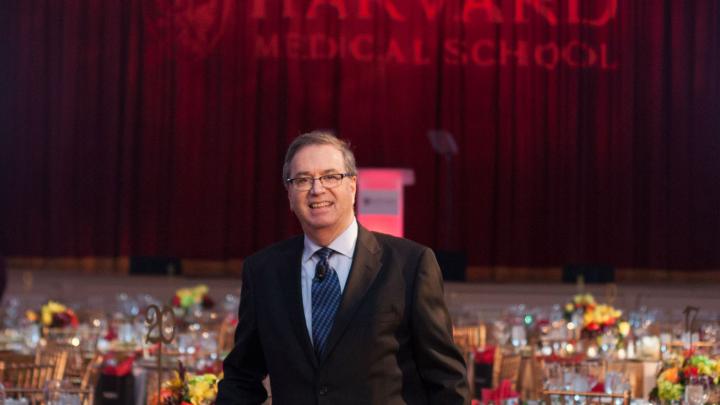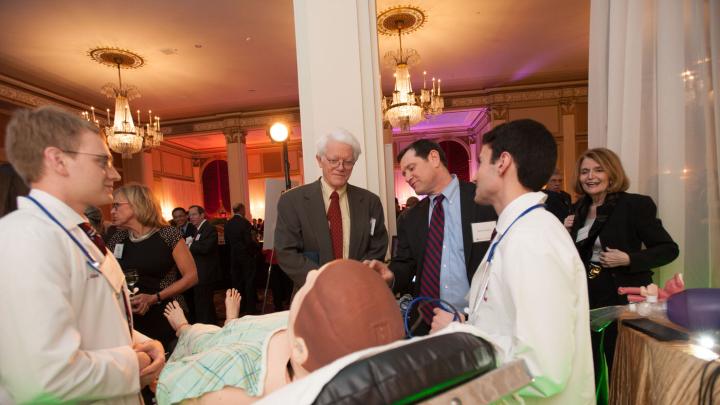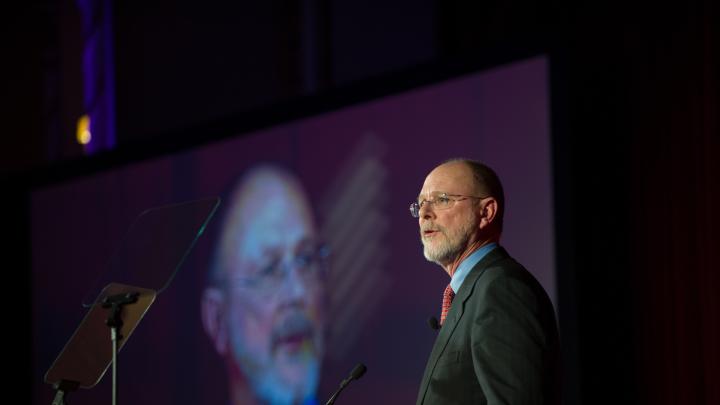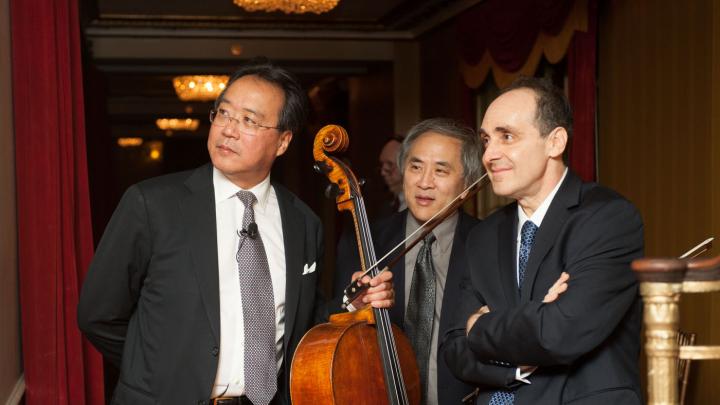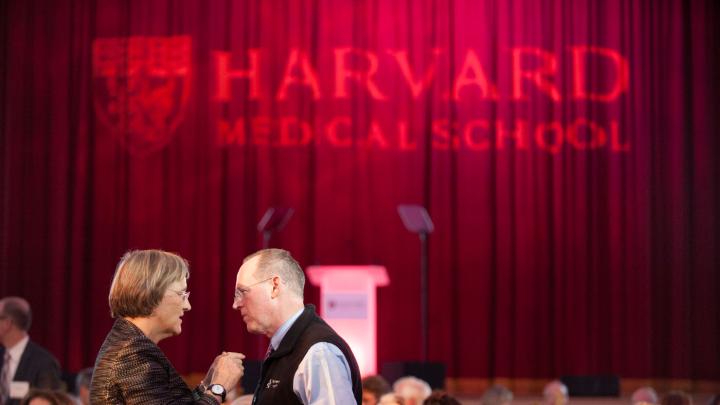The $750-million capital campaign for Harvard Medical School (HMS) kicked off with a gala dinner at the Boston Park Plaza hotel on Thursday evening, November 13. The school’s dean, Jeffrey Flier, gave the keynote, beginning with a story about “something that happened decades ago, to a young diabetes researcher working down in Washington, at NIH [the National Institutes of Health].”
The researcher’s group was baffled because they'd identified several desperately ill diabetic patients who didn’t respond to any dose of insulin doctors administered. Nobody could figure out why—and unless they did, the patients would likely die.
One day, the young researcher had an idea. He told his boss, “Some of these people have autoimmune symptoms. They produce unusual antibodies. Could one of these antibodies block insulin action by attaching to receptors on their cells?”
He feared his boss might say, “Ridiculous.” Instead, he said, “Wow. You’re the first to suggest that idea. Why don’t you test it?”
The next night, after doing an experiment, this researcher sat alone in a little room beside a gamma counter, waiting for it to spit out his data. He was both thrilled—and terrified.
“By now you’ve probably guessed. That young researcher was me,” Flier told the school’s assembled guests. He had gone to medical school planning to become a practicing doctor, but a mentor who was both a great doctor and researcher got him excited about research.
That mentor’s encouragement led Flier to NIH, and to his discovery that antibodies could indeed block the action of insulin. And Flier’s story tied directly to three of the four broadly defined aspirations and priorities of the HMS fundraising campaign:
- educating leaders in science and medicine;
- discovering the causes of disease; and
- fostering innovation and change in the effort to improve human health.
The fourth goal includes work to improve health equity and health systems worldwide, a topic to which Harvard president Drew Faust alluded in her remarks.
In an interview with Harvard Magazine on November 3, Flier provided further details about the campaign goals. The education objectives, he said, encompass both curriculum reform and renovation of physical space. Medical education has always been challenging, the dean explained, because knowledge in the biological sciences has been advancing rapidly for a long time. Now, against that backdrop, have come changes in pedagogy as well. Technology has led to novel educational approaches such as flipped classrooms and facilitated innovations like team-based teaching. And because the school is in the “late stages of planning” a substantive curricular reform, it is also working on designs for a major renovation of its Tosteson Medical Education Center, to address the need for new kinds of teaching spaces. Flier said that the school seeks to raise $150 million to address educational needs, including funding for financial aid and fellowships.
Turning to research, for which the school hopes to raise about $500 million, Flier said, “If you look at the budget of Harvard Medical School and what the people we employ do, the largest number of them are doing research.” In neuroscience, to take just one example, the school is poised to pursue three areas: autism; neuropsychiatric disorders such as bipolar illness and schizophrenia; and neurodegenerative diseases, including Parkinson’s, Alzheimer’s, and ALS (Lou Gehrig’s disease).
But such research, Flier notes, “never fully pays for itself.” Against the backdrop of a long-term decline in federal funding from agencies like the NIH, this problem worsened significantly this past year as federal stimulus funding ended. In fiscal year 2013, for example, sponsored research made up 45 percent of the school’s revenue, according to Harvard’s annual financial report; in fiscal 2014, that dropped to 43 percent—a harbinger of what is to come. Future research, of necessity, will rely more heavily on philanthropy and nonfederal (corporate, for example) sponsorship, funding which—unlike federal support—rarely covers the cost of infrastructure, thus putting additional pressure on central budgets. (Approximately 26 percent of HMS’s annual revenues come from its endowment, currently $4.214 billion, in size second only to that of the Faculty of Arts and Sciences.)
The third priority, Flier continued, is grouped under the umbrella of service; it includes global health, health policy, and primary-care initiatives. HMS, by partnering with nongovernmental organizations such as Partners In Health (PIH is actively involved abroad in healthcare delivery and the improvement of healthcare systems in low-income countries like Rwanda and Haiti), has been able to engage in research into the delivery of healthcare in underserved areas, into the implementation of new diagnostic and therapeutic strategies, and even into basic-science research. (Efforts in these areas focused on the Ebola outbreak in West Africa form one example; they range from the testing of novel diagnostic techniques in community-care centers in Rwanda and even—potentially—to the testing of a vaccine, were one to become available.) The campaign’s $50-million goal for such work has already been raised, but Flier hopes to raise more, given the dramatic returns in lives saved and improved in the world’s most underserved countries.
The final priority, focused on innovation, seeks discretionary funds that the school’s leadership will use to take on “unanticipated opportunities.” Within that mandate, explained Flier, is a “specific program for facilitating and seeding translational research,” the Harvard program in Therapeutic Science—an effort to “identify research that with a little infusion of resources and guidance can be taken another step: to translational application either through pharmaceutical or government funding.”
Campaign chair Joshua Boger, Ph.D. ’79, founder and former CEO of Vertex Pharmaceuticals Inc., announced at the dinner that the school has so far raised $375 million, or half its fundraising goal. That sum includes a $90-million gift from Ludwig Cancer Research received last January—obviously, a substantial downpayment on HMS’s research agenda.
Boger emphasized in an interview the obligation of research institutions that receive federal funding to develop work that will benefit mankind. That federal-funding system is the envy of other nations, he said, and for the past 40 to 50 years, “it has been a very good investment.” But there is an expectation of benefit that accompanies the receipt of public funds: they represent “a social contract, not just beneficent cultural support.” Translational research is therefore an important part of the “ecology” of the institution, Boger said, along with a core commitment to basic science.
Given its mission of alleviating human suffering, HMS has a more public-facing role than many of Harvard’s other schools, and the sources of the philanthropic donations it receives reflect this. With an alumni base only about one-tenth the size of Harvard College’s, for example, the school must rely on outside donations. Boger said he believes fellow donors recognize that people who want to maximize the effect of their dollars in an area as complex as biomedicine owe it to themselves—as “an intellectual, if not a moral responsibility”—to “invest in a place of strength” like HMS, given that the school is a “nexus for research that extends all over the world”: sentiments he repeated at the campaign dinner.
The evening gala celebration and dinner had begun with informal student presentations focused on the school’s priorities. Sim-man, a dummy experiencing symptoms of distress such as elevated heart rate (who apparently needed an intubation), exemplified changes in modern medical education (first-year students begin working with “him” in their very first week). And a presentation on mobile medical delivery in local Boston neighborhoods (familyvan.org) that featured audio interviews (produced by second-year medical student Zoe Bouchelle) with the program’s diverse clientele exemplified the school’s commitment to health equity. The night ended with a musical performance by a former student, and a reminder that in some cultures, music and medicine have been linked by their power to heal. Playing beautifully enough to prove the point, the Longwood Symphony Orchestra performed two Brahms works for piano, accompanied by the “Harvard Trio”: Richard Kogan ’77, M.D. ’81, Lynn Chang ’75, and Yo-Yo Ma ’76, D.Mus. ’91. The peace that settled over their audience was a palpable reminder of the diverse ways an institution devoted to healing goes about its business.
